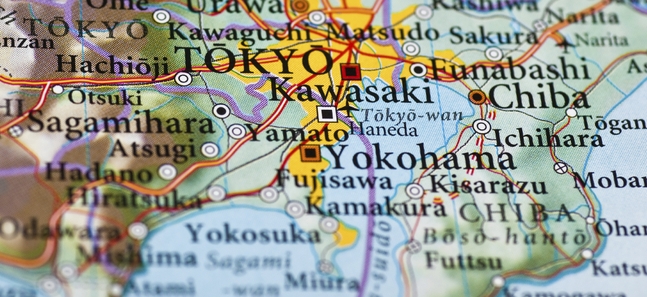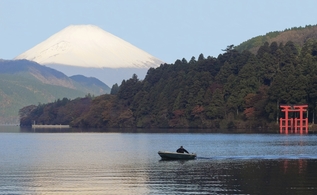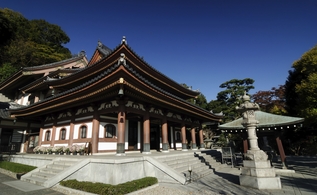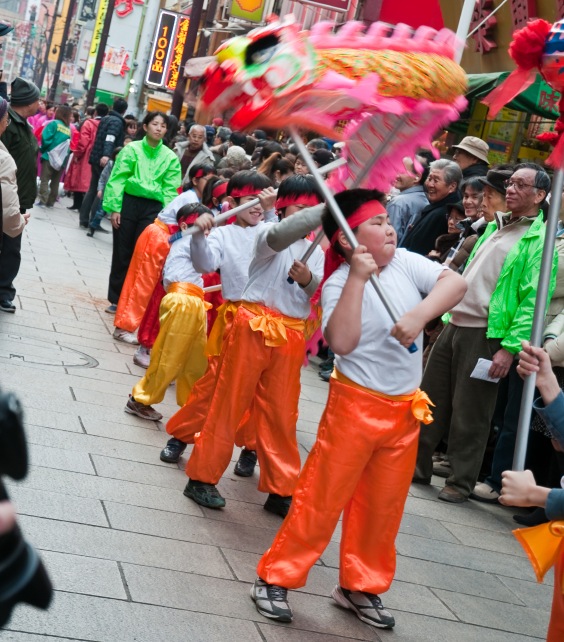Day trips and weekend breaks: Kanagawa Prefecture
What to do and where to go when you need to get outta town

Posted: Mon Apr 25 2011
Kanagawa
Hakone
 If you only do three things...
If you only do three things...
Hakone Ropeway
It's Japan’s longest – and the world’s busiest – cable-car route, a four-kilometre ride over the peaks and valleys of Hakone. Around halfway along its length is Owakudani, the ‘big boiling valley’: a smoking hillside streaked with traces of sulphur from the volcanic activity below, and where the air simply reeks of rotten eggs. Opening hours depend on season, with monthly timetables featured here. The fare for the full four kilometres is 1,330 yen (adults), 660 yen (kids). Transport: Hakone Tozan Cable Car from Gora Station (Hakone Tozan line)
Hakone Open-Air Museum
A world-class collection of sculptures by Moore, Rodin, Antony Gormley, Alexander Calder, Takamichi Ito and Niki de St Phalle sits exposed to the elements on a mountainside overlooking a series of valleys leading to the sea. There’s also a display of ceramics by Picasso in a separate pavilion. Daily, 9am-5pm (Mar-Nov); 9am-4pm (Dec-Feb). Adults 1,600 yen, kids 800 yen. 1121 Ninotaira, Hakone-Machi, Ashigara-Shimogun, Kanagawa (0460 82 1161, www.hakone-oam.or.jp). Transport: Chokoku-no-Mori Station (Hakone Tozan line)
Hakone Circuit
Those in a hurry can make the most of their time by trying the ‘Hakone Circuit’. Get off the train at either Odawara (Tokaido, Odawara, Shonan-Shinjuku lines) or Hakone-Yumoto (Hakone Tozan line). From there, transfer to the Tozan mountain railway for the 50-minute ride to its terminus at Gora. At Gora, transfer on to the funicular railway up to the end of the line at Sounzan. Here, transfer to the cable car, which takes you down to the banks of Lake Ashinoko at Togendai Station. To get across the lake, board one of the pleasure boats and stay on until Hakone-Machi or Moto-Hakone, from where you can take a bus back to where you started. The round-trip should take about three hours, although in the busy summer months it may take longer.
Where to eat
Bella Foresta
This restaurant in the Hakone Open-Air Museum (see above for opening times and contact details) serves a decent buffet lunch for 1,680 yen, while all the large hotels have at least four restaurants that are open to non-guests.
Where to stay
At the bottom end of the scale is the Kappa Tengoku (777 Hakoneyumoto, Ashigarashimo, Kanagawa; 0460 85 6121), where a double room costs from 6,600 yen per night on weekdays, although its proximity to the railway tracks might mean an earlier awakening than you’d bargained for. If you fancy a real splurge, however, nothing can rival the ten-room Kinnotake boutique hotel (817-342 Sengokuhara, Hakone-machi, Ashigarashimo, Kanagawa; 0460 84 3939, www.kinnotake.com), whose rooms come with a private hot spring and a contemporary Japanese-style interior of the kind that design fans dream about (and a price tag of between 36,000-54,000 yen per person).
How to get there
There are two types of Hakone Free Pass, available at all Odakyu stations and many travel agents. The two-day pass gives you unlimited journeys for 5,000 yen, available from Shinjuku Station. The three-day pass costs 5,500 yen. The ticket price also covers the basic fare on an Odakyu train from Shinjuku to Hakone. If you want to travel in comfort on the super-express Romance Car, you will need to pay a supplement of 870 yen.
Kamakura
 If you only do three things...
If you only do three things...
Hase-Dera
Not far from the famous Daibutsu (Kotokuin temple) lies Hase-Dera (also known as Hase Kannon). The main feature here is the 11-faced statue of Kannon (goddess of mercy and compassion), carved in 721 AD out of a single camphor tree. The temple is also famous for its thousands of small Jizo figurines offered in memory of deceased children and babies (including those who were never carried to full term). Hase-dera is known for its hydrangea that bloom each June, and enjoys a panoramic view of the town, the beach and Sagami Bay year-round. Daily, 8am-5pm (Mar-Sep); 8am-4.30pm (Oct-Feb). Adults 300 yen, kids 100 yen. 3-11-2 Hase, Kamakura, Kanagawa (www.hasedera.jp). Transport: Hase Station (Enoden line)
Kencho-ji
The oldest Zen temple in Japan is an imposing place, with large buildings and grounds, although only ten of the 49 original sub-temples survive. Many of the halls have been rebuilt, but their arrangement hasn’t changed for over 700 years. Behind the last building there’s a garden from which a path leads to steps climbing to Hanso-bo, a shrine where the guardian of the temple resides. From here you can head along the Ten-en hiking path, which follows the hilltop ridge as far as Zuisen-ji temple in the east of Kamakura. Daily, 8.30am-4.30pm. Adults 300 yen. 8 Yamanouchi, Kamakura, Kanagawa. Transport: Kita-Kamakura Station (Yokosuka line)
Tsurugaoka Hachiman-gu
Kamakura’s main shrine is a ten-minute walk from the central station. Hachiman is seen today as the god of war, but in the past he was regarded as the guardian of the whole nation. As one of the most important Shinto shrines in eastern Japan, this is an essential stop for all visitors. The nearby Komachi Dori, a narrow pedestrian street lined with souvenir and craft shops, boutiques, food stalls and shops, is also well worth checking out. Daily, 6am-8.30pm. 2-1-31 Yukinoshita, Kamakura, Kanagawa (0467 22 0315). Transport: Kamakura Station (Yokosuka, Shonan-Shinjuku line)
Where to eat
Near to Kamakura Station is Nakamura-an, a cosy noodle shop serving hearty, hand-chopped soba for as little as 700 yen (1-7-6 Komachi; 0467 25 3500, www.nakamura-an.com). In Kita-Kamakura, you can try a taste of Zen at Hachinoki Honten, which serves shojin ryori vegan cuisine at a price (lunch starts at 2,310 yen. 7 Yamanouchi; 0467 22 8719).
Where to stay
By train, Kamakura is less than an hour's journey from Tokyo, making this the ideal day trip.
How to get there
Both Kita-Kamakura and Kamakura stations are on the JR Yokosuka line from Tokyo (890 yen, single) and Shinagawa (690 yen) stations; trains run every 10-15mins. There’s a more limited service on the JR Shonan-Shinjuku line from Shinjuku and Shibuya (890 yen). A special two-day return, including unlimited rides on the Enoden line and Shonan Monorail, is the Kamakura-Enoden Free Ticket (1,970 yen). A cheaper but longer (90 mins) option is to take the Odakyu line from Shinjuku to Enoshima (610 yen; 1,210 yen by express), then transfer on to the Enoden line (250 yen to Kamakura). Day-trip tickets (also with unlimited rides on the Enoden) are available for 1,430 yen.
Yokohama
 If you only do three things...
If you only do three things...
Sankeien
When religious relics were being torn down as religion fell from official favour in the Meiji era, a local merchant decided to save the treasures from the bulldozer, importing them from across Japan. The grounds of this garden now house a three-storey pagoda from Kyoto, and a feudal lord’s residence among many other priceless structures. Daily, 9am-5pm. Adults 500 yen, kids 200 yen. 58-1 Honmoku-Sannotani, Naka-ku, Yokohama, Kanagawa (045 621 0635; www.sankeien.or.jp). Transport: Bus 8 or 148 from Yokohama Station (bus stop 2), getting off at Honmoku Sankeien-mae
World Cup Stadium
We're including this for its sheer quirkiness. The venue that hosted the Germany v Brazil final in 2002 offers tours, taking in the dressing rooms, practice area and pitch. See the Brazilians’ tactic-covered whiteboard, take a shot at a silhouette of German goalie Oliver Kahn and gaze in awe at the rubbish the teams left behind. There’s also a chance to run out on to the pitch (well, as far as the running track) with the World Cup anthem blazing. Open daily. Tours (on days when the stadium is not in use), 10.30am, midday, 1.30pm, 3pm. Adults 500 yen, kids 250 yen. 3300 Kozukue-cho, Kohoku-ku, Yokohama, Kanagawa (045 477 5000, www.nissan-stadium.jp). Transport: Shin-Yokohama Station (Tokaido Shinkansen, Yokohama lines)
Chukagai
Start off at the Suzakumon, one of the ceremonial gates to Yokohama’s Chinatown (Chukagai in Japanese). The biggest such community in Japan, it is home to hundreds of Chinese restaurants and shops and you can eat well after wandering the colourful streets (see below). Transport: Motomachi-Chukagai (Minato Mirai line)
Where to eat
Tung Fat (Dohatsu Honkan)
This Chinatown spot is popular for its Hong Kong-style seafood dishes, and at lunchtime customers jostle for position while the strict mama-san tries to keep everyone in check. While waiting, look at the window display of mouth-watering meats, whole chickens and ducks, sausages and less recognisable animal parts. Daily, 11am-9.30pm; closed first and third Tue of month. 148 Yamashita-cho, Naka-ku, Yokohama, Kanagawa (045 681 7273, www.douhatsu.co.jp). Transport: Ishikawa-cho Station (Negishi line)
Where to stay
More of a day trip from Tokyo than a weekend break, you can be back in the capital in a mere 25 minutes on the Tokyu Toyoko line.
How to get there
A super-express on the Tokyu Toyoko line from Shibuya Station takes 25mins to reach Yokohama station (260 yen single) or 33mins to its terminus at Motomachi-Chukagai (460 yen). From Tokyo Station, the JR Tokaido line is the fastest option (30mins, 450 yen).
Tweets
- About Us |
- Work for Time Out |
- Send us info |
- Advertising |
- Mobile edition |
- Terms & Conditions |
- Privacy policy |
- Contact Us
Copyright © 2014 Time Out Tokyo


Add your comment